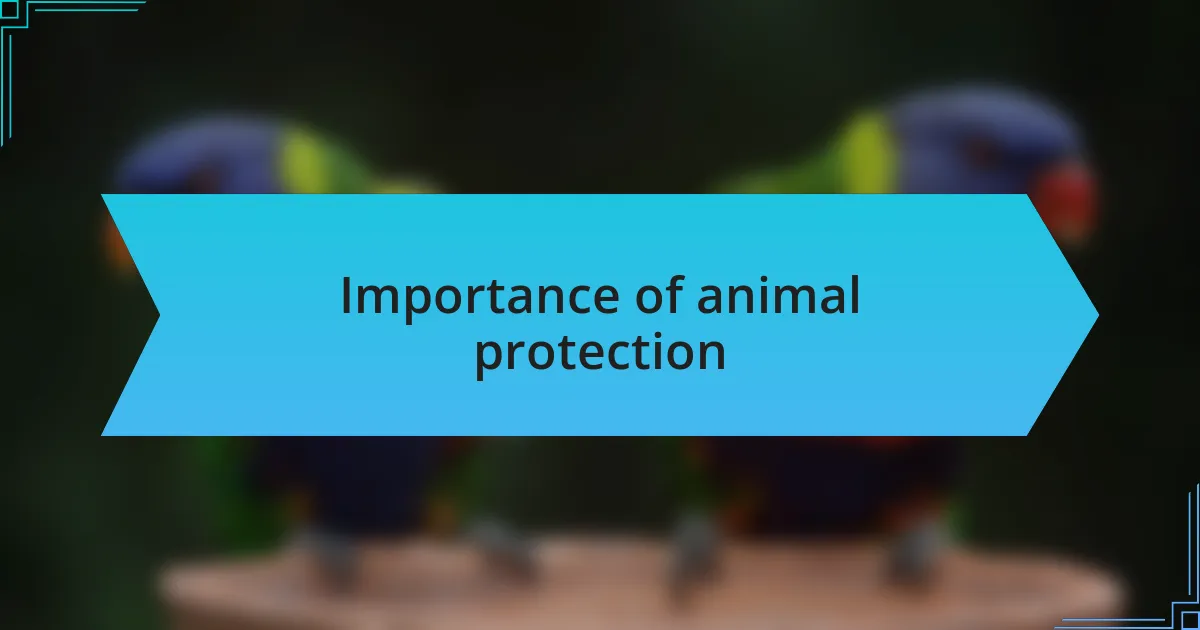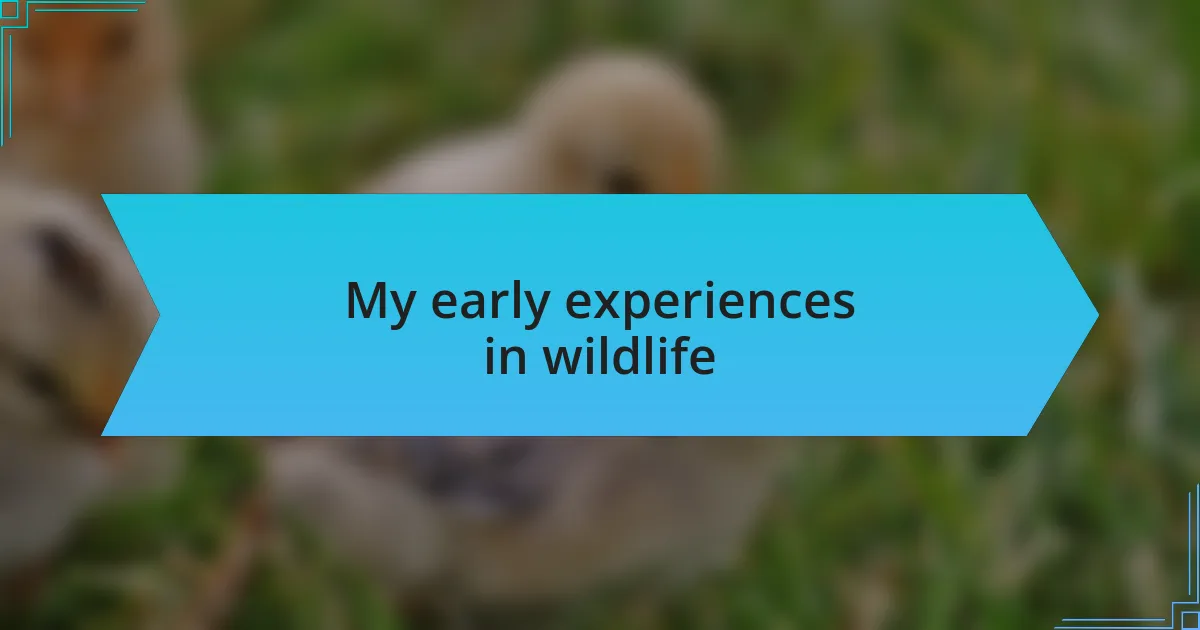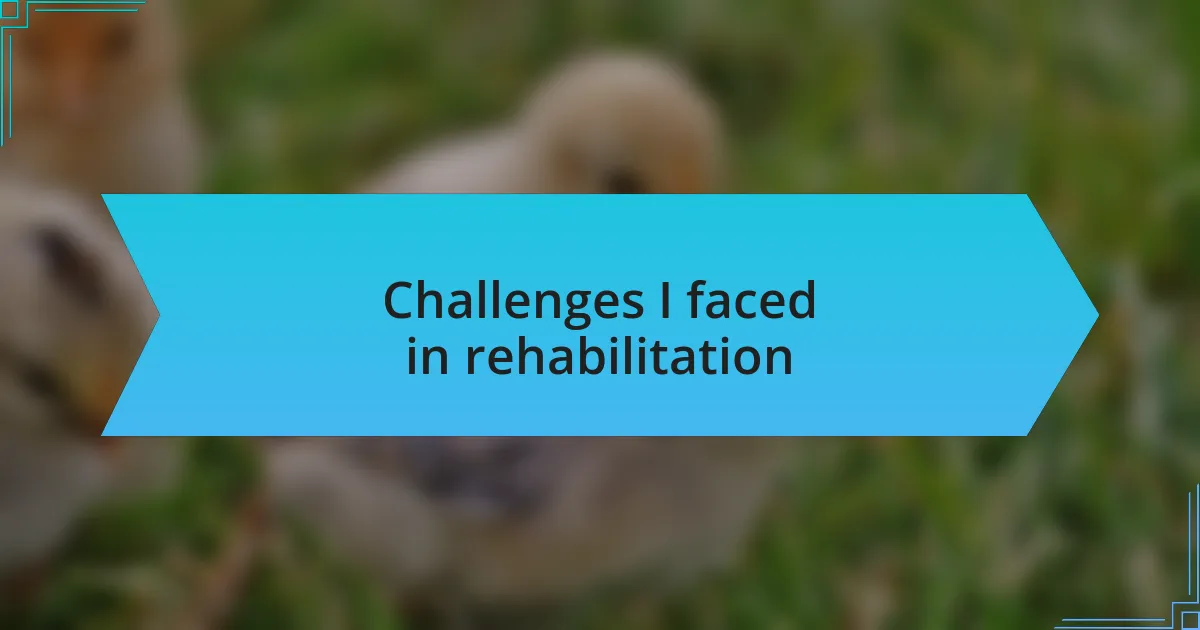Key takeaways:
- Wildlife rehabilitation requires a deep understanding of animal behavior, species-specific needs, and emotional connections to the animals cared for.
- Advocating for animal protection is essential for preserving ecosystems and fostering community empathy and involvement.
- Becoming a wildlife rehabilitator involves education, practical experience, and obtaining necessary permits to provide appropriate care.
- Challenges in rehabilitation include emotional tolls, financial constraints, and the need for community support to ensure effective animal care.

Understanding wildlife rehabilitation
Wildlife rehabilitation is a hands-on process that aims to care for injured, sick, or orphaned animals, ultimately preparing them for life back in the wild. I remember the first time I held a little sparrow that had fallen from its nest; feeling its fragile body in my hands was a profound moment. It made me question how often we overlook the plight of these creatures in our everyday lives.
The rehabilitation journey involves not just medical care but also a deep understanding of each species’ unique needs. I recall spending countless hours researching the behavior and habitat of the animals I was helping. It struck me how crucial it is to recognize that every animal has its own story and adaptations that evolution has finely tuned over generations. Can you imagine trying to treat a wild animal without understanding its instinctual behaviors?
In my experience, the emotional connection we form with the animals can be both rewarding and challenging. Each time I released a rehabilitated animal back into its natural environment, it felt like letting go of a piece of my heart. This bittersweet moment made me realize that rehabilitation is not just about saving lives; it’s about fostering a greater respect for wildlife and acknowledging our role in their survival.

Importance of animal protection
The significance of animal protection cannot be overstated. I recall a time when I encountered a wounded fox on the side of the road. The urgency of that moment made me realize how vulnerable wildlife is in our rapidly changing world. Without proper protection, countless animals face threats that can be easily mitigated with our support and awareness.
Protecting animals isn’t just about safeguarding their lives—it’s about preserving our ecosystems. During my journey, I learned that every species plays a pivotal role in its environment. For instance, when I helped rehabilitate a family of raccoons, I understood that their role in seed dispersion helps to maintain the balance of the forest. Isn’t it fascinating how interconnected we all are?
Furthermore, advocating for animal protection fosters empathy within our communities. I’ve seen how sharing stories of recovery can inspire others to take action. When I spoke about the injured hawk I cared for, many were moved to contribute, whether it was by volunteering or making donations. Isn’t it amazing how one story can spark a ripple of kindness?

Steps to become a rehabilitator
To become a wildlife rehabilitator, the journey often begins with gaining a solid education in animal science or a related field. I vividly remember sifting through textbooks and notes, hungry to absorb every detail about animal anatomy and behavior. This foundational knowledge proved invaluable when I faced challenging cases, such as a baby bird struggling to fly. Understanding its developmental stages allowed me to provide the appropriate care and support.
Next, practical experience is crucial. Volunteering at a rehabilitation center provided me with hands-on skills that no textbook could teach. I recall my first encounter with an injured deer; the panic and uncertainty were overwhelming. Yet, with each interaction, I gained confidence and learned the nuances of caring for different species. Don’t you think working directly with animals makes the experience much more impactful?
Finally, obtaining the necessary permits and certifications is essential. I remember the thrill of receiving my wildlife rehabilitator’s permit; it felt like a significant step toward my dream. The application process can be lengthy and sometimes complicated, but the effort pays off when you realize you’re officially recognized to help wildlife in need. Have you ever pursued something that felt so rewarding after a long journey? The sense of achievement is truly motivating!

Essential skills for rehabilitators
To be effective as a wildlife rehabilitator, strong communication skills are paramount. I recall an instance where I had to explain to a worried pet owner why their dog had likely encountered an injured bird. Explaining complex information in simple terms not only eased their anxiety but also ensured they understood the importance of leaving the bird undisturbed. This skill extends beyond talking; it involves listening and empathizing with others, creating a supportive environment for both animals and their caretakers.
Problem-solving is another critical skill that often comes into play. There was a time when I was faced with a raccoon that had gotten itself tangled in a net. It took quick thinking and careful planning to safely extract the animal without causing it further stress or injury. Developing these problem-solving tactics can make the difference between life and death for some wildlife. Can you imagine dealing with unexpected issues daily, where each decision weighs heavily on the life of a creature in your care?
Lastly, patience is a virtue that cannot be overstated. Wildlife rehabilitation is not a sprint; it’s a marathon. I remember caring for a young fox that initially resisted all my efforts to help. It took weeks of slow, gentle interaction before it began to trust me. This journey taught me that the rewards of rehabilitation often require time and perseverance. Isn’t it amazing how patience can reveal the most profound connections?

My early experiences in wildlife
My early experiences with wildlife began in my childhood, immersed in nature and often searching for injured or abandoned animals. I vividly recall the thrill of discovering a nest of baby squirrels that had fallen to the ground. Carefully reuniting them with their mother was my first taste of wildlife rehabilitation, a moment filled with excitement and hope. Did that small gesture ignite a passion in me? Absolutely. I felt a surge of purpose as I witnessed the mother squirrel cautiously approach, lift the babies, and carry them back to safety.
As I grew older, I volunteered at a local wildlife sanctuary during my summers. There was this unforgettable day when a small injured owl was brought in; its large eyes reflected both fear and trust. I spent hours sitting beside its enclosure, talking softly and ensuring it felt safe. It was a lesson in respect and connection—the owl’s gradual ease around me felt like a shared understanding, a reminder of how vital it is to approach wildlife with compassion. Who would have thought that my quiet presence could make such a difference in another creature’s healing process?
Even today, I can’t help but reminisce about my first run-in with a fawn, separated from its mother. I felt an overwhelming mix of urgency and concern. After carefully observing the fawn’s behavior, I realized it was only resting and not abandoned. That experience taught me the importance of patience in wildlife. Each encounter shaped my understanding that sometimes, nature knows best, and our role is to protect without interfering unnecessarily. How fascinating is it that this delicate dance between intervention and observation is what elevates wildlife rehabilitation into an art form?

Challenges I faced in rehabilitation
While working as a wildlife rehabilitator, I encountered numerous challenges that often tested my resolve. One of the most difficult moments occurred when I received a group of raccoon kits that had been orphaned after a storm. Establishing a feeding routine felt relentless; each hour felt like an eternity, and I worried about whether I was providing the right nutrients. I often found myself asking, am I doing enough to give them a fighting chance?
Financial constraints were another hurdle that I couldn’t overlook. Essential medical supplies, proper housing, and nutritious food often stretched my budget thin. There were nights I lay awake wondering how I could fund the care that these animals deserved and would there be enough support from the community to sustain our efforts? It was a poignant reminder that passion alone doesn’t fill the gaps—sometimes, it takes a village to truly make a difference.
One particularly heart-wrenching experience involved an injured deer who arrived at our facility in critical condition. After extensive attempts to stabilize her, I realized she wasn’t going to make it. Standing there, feeling both helpless and grief-stricken, I understood firsthand the emotional toll this work entails. How could one moment of care lead to such profound sorrow? In this field, every loss weighs heavy, but it also fuels the determination to continue making every effort for the animals in our care.

Future goals in wildlife rehabilitation
As I look to the future in wildlife rehabilitation, one key goal is to enhance community education about local wildlife. I often reflect on how misinformed perceptions can lead to unnecessary harm to animals. By hosting workshops and engaging school groups, I hope to foster a deeper appreciation for these creatures and help others understand their role in the ecosystem. Will this not only inspire compassion but also encourage people to act as stewards for wildlife?
Another aspiration is to strengthen collaboration with other wildlife rehabilitators and organizations. During my journey, I’ve found that sharing knowledge is invaluable. One time, a fellow rehabilitator shared a technique for nursing a fledgling bird back to health that drastically improved my success rate. Can you imagine the impact we could have if we create a network that pools our resources and expertise? Together, I believe we can elevate the standards of care and rehabilitation.
Additionally, I am committed to advocating for better policy support for wildlife protection. I’ve seen firsthand how regulations can both hinder and help rehabilitation efforts. It’s disheartening to see animals suffer due to legal limitations on care. What if our advocacy led to improved laws that better protected wildlife and the environment? That vision drives me forward as I work to make a meaningful impact for the future of wildlife rehabilitation.